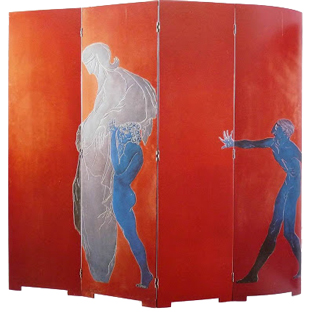Legacy
Persuaded by Jean Badovici, Eileen Gray turned her interests to architecture. In 1924 Gray and Badovici began work on the house E.1027 in Roquebrune-Cap-Martin in southern France, near Monaco. The codename stands for the names of the couple: E for Eileen, 10 for Jean (J is the tenth letter of the alphabet), 2 for Badovici and 7 for Gray. Rectilinear and flat-roofed with floor-to-ceiling and ribbon windows and a spiral stairway descending to a guest room, E.1027 was both compact and open. Gray designed the furniture as well as collaborating with Badovici on its structure. Her circular glass E.1027 table and rotund Bibendum armchair were inspired by the recent tubular steel experiments of Marcel Breuer at the Bauhaus, who had been inspired, in turn, by Mart Stam. Le Corbusier was quite impressed by the house, and built a summer house nearby. Le Corbusier left his mark on the building in the form of several colourful wall murals. Gray vehemently disapproved of the murals, created at Badovici’s behest, as they destroyed the integrity of the wall planes. When Le Corbusier died in 1965 he was swimming in the sea directly in front of E.1027.
The house has been in poor repair for years, but plans for its renovation are being prepared by the French government, who have designated it a French National Cultural Monument. As a result the state of France and the city of Roquebrune Cap Martin — through the national agency “Conservatoire du Littoral”) — bought the villa in 1999 and made it secure provisionally. Visiting E.1027 in the early month of 2008 it seems the devastated condition will be history in the near future. The building is surrounded by a scaffold, the property is gated with a fence recently installed and building worker are busy in- and outside the building. A signboard informs that E.1027 will be restored: the restoration is an initiative of the state of France, the department “Alpes Maritimes” and the city of Roquebrune, bearing 50% / 10% / 40% of the expenses.
In 1968, a complimentary magazine article drew attention to her accomplishments, and Gray agreed to production of her Bibendum chair and E.1027 table as well as numerous other pieces with Zeev Aram. They were soon to become modern furniture classics. Following the purchase of her archive in 2002, the National Museum of Ireland at Collins Barracks, Dublin opened a permanent exhibition of her work. On 8 November 1972, the Doucet sale added to the interest which continues to this day in the “antiques” of the twentieth century. Gray’s “Le Destin” screen was featured in the sale and went for $36,000. Collectors entered the chase, and Yves Saint Laurent’s interest completed the mythification of her image.
In February 2009, a “Dragons” armchair made by Gray between 1917–1919 (acquired by her early patron Suzanne Talbot and later part of the Yves Saint Laurent and Pierre Bergé collection) was sold at auction in Paris for 21.9 million euros (US$28.3 million), setting an auction record for 20th century decorative art.

